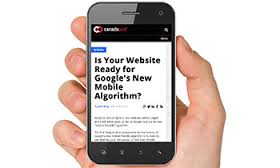Is Your Website Ready For Google’s Mobile-First Indexing?
 You’ve been hearing for some time that you need to have a Responsive Website (one that automatically reconfigures to the device from which you are viewing, whether desktop, tablet or smart phone).
You’ve been hearing for some time that you need to have a Responsive Website (one that automatically reconfigures to the device from which you are viewing, whether desktop, tablet or smart phone).
You may also have heard that Google penalizes websites that are not responsive by making them appear lower on the search results page when one searches on a mobile device.
What you may not have heard is that Google recently announced it has started experiments to make their indexing “mobile-first.” Thus, Google algorithms will eventually, primarily, use the mobile version of a site’s content to rank pages.
What the new algorithm will mean to you:
Your site’s mobile experience will be the primary point of reference when your content is indexed, not your desktop pages (which is the case currently). If you already have a responsive site and have not reduced the amount of content to better fit the mobile form factor, then you have nothing to be concerned about.
If you either have a separate mobile site or the mobile version of your desktop site is appreciably different than the desktop site — from a content perspective, the following is Google’s advice for those with “a site configuration where the primary content and markup is different across mobile and desktop:”
Warning: For those of you who are non-technical marketers, I suggest you share these steps with your web developer or SEO expert as Google does not present them in layman’s terms:
-
- Make sure to serve structured markup for both the desktop and mobile versions.
- Sites can verify the equivalence of their structured markup across desktop and mobile by typing the URLs of both versions into the Structured Data Testing Tool and comparing the output.
- When adding structured data to a mobile site, avoid adding large amounts of markup that isn’t relevant to the specific information content of each document.
- Use the robots.txt testing tool to verify that your mobile version is accessible to Googlebot.
- Sites do not have to make changes to their canonical links; we’ll continue to use these links as guides to serve the appropriate results to a user searching on desktop or mobile.
Need some help managing the change? Please contact us. We’re here to help.


